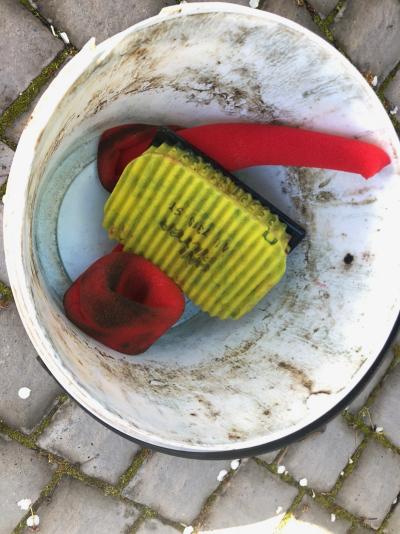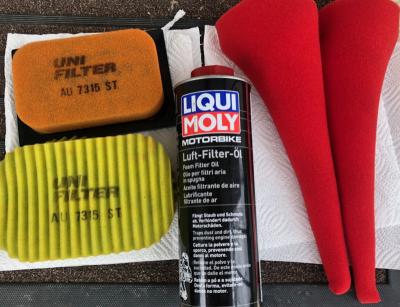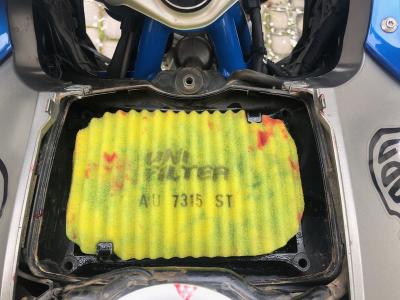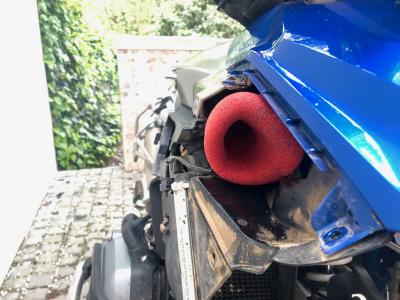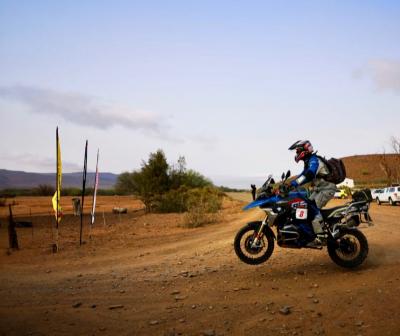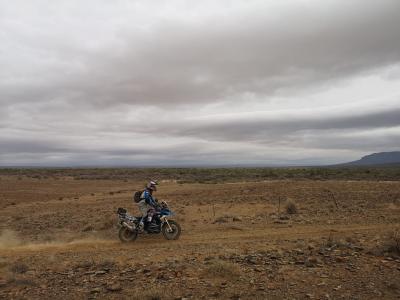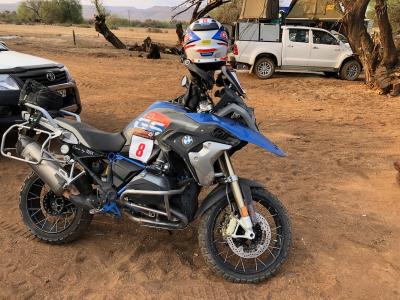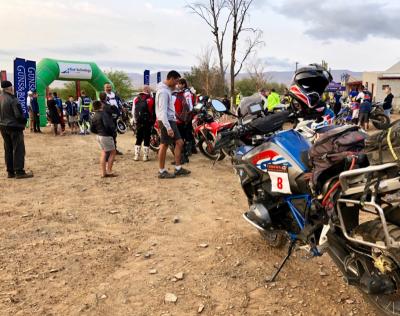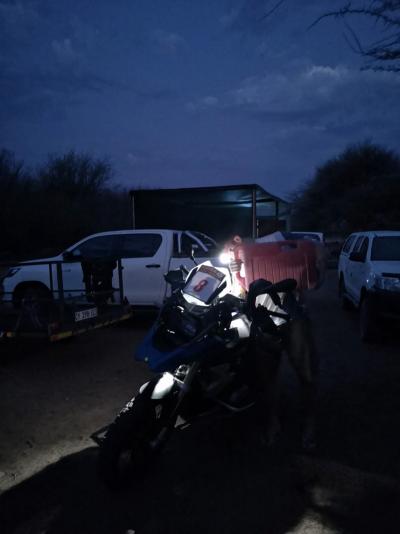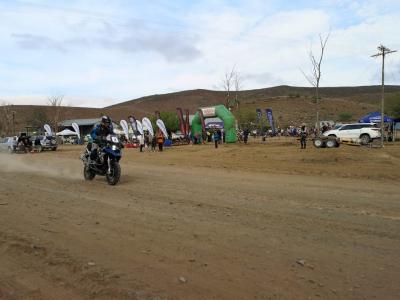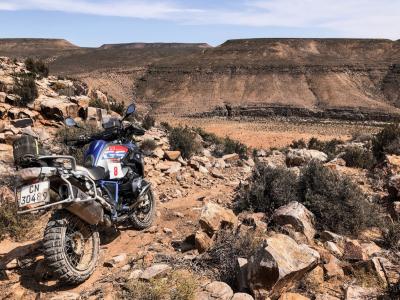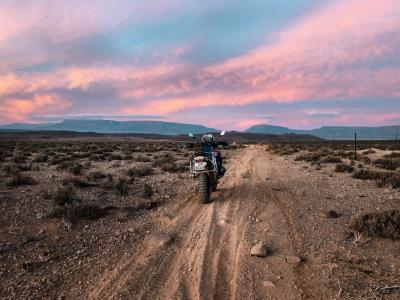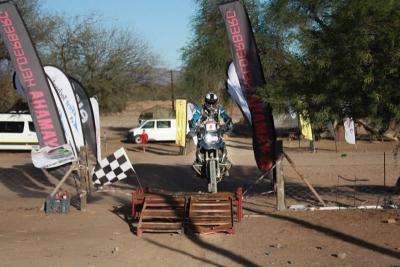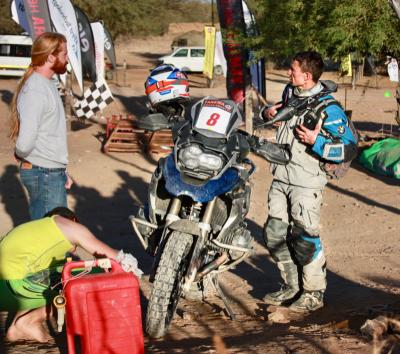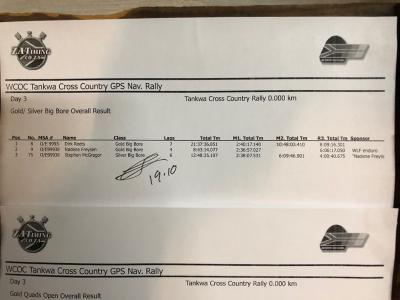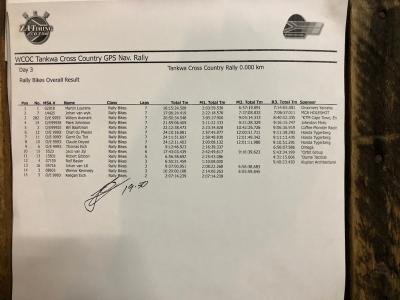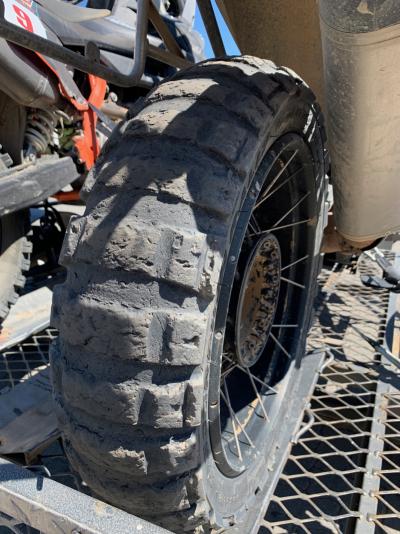Tankwa Cross Country Rally on a BMW R1200GS
I apologize in advance for any typos and language errors... this report turned out to be quite a bit longer than I had planned and I don't want to spend too much time reviewing it.
Prologue
A few of my friends entered to ride in the Tankwa Cross Country Rally this year. I do suffer from a rather serious case of FOMO when bike riding is involved… so a plan had to be made.
At this point it is worth mentioning that I had been tempted to try my hand at rallies before. In 2017 I bought a 501, long range tanks etc - determined to ride the West Coast Baja and Amageza the following year. Unfortunately, Alexander passed away and the future of those rallies seemed uncertain. I sold the bike and got a KTM 300 in its place. There are many enduros and funduros that one can ride, so the switch made sense to me.
Back to Tankwa. I had a few options… my 300 would work in the silver off-road class. Someone also generously offered to lend me a 701 for the event. And then there was my 1200GS. Out of these three options the GS was the obvious underdog. That is exactly why I started wondering if it would be possible to do the Tankwa Rally on a big adventure bike. Off course there is only one way to find out…
I called Clive and asked him if there were any major step ups along the way - the kind that would not be doable on a big adventure bike. His response was that it would be very tough to do it on a big adventure bike, but that he didn’t think that there were obstacles that couldn’t be ridden or at least avoided by taking a penalty. He also confirmed that it hadn’t been done on a GS or 1090/1190/1290 before, so this would be a first. Temptation raised ;)
My second call was to David Ellis (Watch his YouTube videos if you don’t know who he is!). David said it might be possible to do it on a big adventure bike and that it would be a ‘lekker’ challenge.
At this point my mind was made up. This would be a good test for both the bike and for myself. The only real failure would be to not even attempt it. The next day I entered to race in the Gold Big Bore class. This class would run the same route as the Rally class but would navigate by GPS instead of roadbook.
My primary goal was to successfully complete all stages in the Rally class route with myself and my bike intact. Ideally, without having to cut out any parts of the intended route – so without penalties. Secondary to that – and this I kept mostly to myself – I wanted to see if I could beat the total time of at least one of the Rally class bikes. This is not comparing apples with apples, but still a valuable reference. More on that later.
Preparation
I decided to take the bike pretty much “as is” with the exception of fitting a new pair of Pirelli Scorpion Rally tires and carrying an 18” heavy duty tube – in case one of my tires got a bad cut. This is something I carry on longer expeditions as well. My standard adventure toolkit stayed on the back of my bike, I wore my adventure riding suit and carried my expedition backpack from Leatt with a medical kit, 2x2l hydration bladders and some protein bars. My goggles were also in my backpack (something that I don’t usually take on adventure rides) and that turned out to be VERY useful in the dust.
In our group we had three gazebos, synthetic grass (lent to us by Synsport), tools, consumables and all the camping equipment one needs for a weekend like this. It is great to do this with a group of friends!
You need to take all the fuel that you’ll need for the entire race along. I decided to take 110l for the GS – that would allow me to complete the race at anything better than 11km/l.
I didn’t take any spare parts, spare tires, oil etc. along.
As far as I was concerned, this was basically going to be like an adventure ride – just a bit faster ;)
Day 0
Between fitting all our equipment, supplies, fuel for two bikes etc. on the double cab and participating in some last-minute teleconferences, we managed to leave Constantia at 11:00 on Thursday morning. We drove up the N7 to Van Rhynsdorp, from there to Calvinia and then 60km down the R355 to HQ. One of the vehicles in our group lost a tire to a sidewall cut… the R355 is notorious for that.
We arrived at HQ after 17:00. The documentation process was very efficient, and we soon headed towards scrutineering with our bikes.
To say that the GS was ‘frowned upon’ would be an understatement… I was asked several times by different officials if I knew what I was getting myself into. Despite the frowns, my tracker and transponder were fitted, and I got through scrutineering without any issues.
Once we got all our bikes through scrutineering we setup camp. The wind was loaded with red dust and pumping. At this point I wondered if the hardest part of the weekend wasn’t going to be to keep the tents grounded and semi-clean :D
The riders’ briefing started at 20:00. After the briefing we got our GPSes back – loaded with the tracks for Day 1. I confirmed that my GPS could load all the tracks and that the tracks corresponded – more or less – to the maps that were put up on the boards. At this point I realized that the tracks on the GPS was for the Gold class routes and not for the Rally class routes. The problem was soon rectified by the officials and we were ready for the next day.
By this time the wind had died down and it turned out to be a stunning Karoo evening. We spent a bit of time chit-chatting with existing friends and making new friends before we headed to bed early-ish.
Day 1 – Time Trail
We woke up at 06:00, got dressed and made ourselves some coffee and breakfast. Excitement was visible everywhere!
Shortly after 07:00 our bikes were lined up for the start of the time trail – that would be the first stage of the race for all classes. The time trail started and ended at HQ and all classes used the exact same route. The rally class would start first, followed immediately by the Gold Big Bore class. There would then be a delay after which the off-road classes would start the route. The route was approximately 90km long – if I remember correctly.
The 15 bikes in the Rally class were set off with 30 second dust gaps and before I knew it, I was on the line to start my first rally!
A few hundred meters from the start we got to a dry riverbed. For several kilometres the track followed the riverbed by either running inside the riverbed or following single tracks right next to it. Some sections of the riverbed were 5+ meters wide and fairly straight – the GS could run a reasonable pace there despite the soft sand. In other parts the riverbed was so narrow (1 to 2 meters) that it was impossible to miss all the branches from the thorn trees along the ever-twisting track. This was slow going on the GS. Riding a big adventure bike in sand is best done with momentum and this twisty track didn’t allow for that. I was forced to ride stretches in 1st gear and had to work hard to keep the bike in the track and to avoid getting stuck. By the time I got out of the riverbed section I was properly warmed up (Read sweaty).
We crossed the R355 from where the route took us along some farm roads. Here and there the route would cut across a small riverbed or piece of field to join another road. The GS was happy in this terrain. I got speeds of up to 140km/h on the GPS which allowed me to cool down and to relax enough to drink some water.
After about 15 minutes of riding, the tracks became a bit bumpier with occasional ruts / ditches. On an off-road bike one can ride over most of these without slowing down too much, but the GS’ suspension doesn’t really allow for that. I had to perform a few emergency brakes to slow right down, go through a ditch in first gear and then accelerate again.
At this point in the stage, I started wondering what a ‘clipper’ looks like. We were warned during the riders’ briefing that there would be significant time penalties for not stopping and clipping our cards. There were some waypoints marked on the GPS tracks, so I wondered whether those would perhaps be the clippers. I stopped at two of the waypoints to look around for these mysterious clippers… Between the first and the second waypoint, I passed one of the rally class bikes that were overheating. At the second waypoint, Robert caught up with me again and I stopped him to ask if the roadbook said anything about a clipper in that area. It didn’t, so we decided to just continue riding.
Shortly after the second waypoint we passed a spectator viewpoint. By this time David Ellis and one other rider from the Gold off-road class had overtaken us. The GS got a pretty loud cheer. Most of the bikes probably did! The next 15 or so minutes were spent riding more tracks with ruts / ditches and some single tracks that cut across fields. Not too difficult on the GS, as long as you keep an eye out for termite nests and big holes.
The final part of the time trail took us back to the river where the stage started. By now all of the off-road classes had been through the narrow riverbed paths and more of the fast Gold off-road riders started to catch up with me. I tried to be polite and allowed a few of the off-road bikes to pass me in the riverbed sections. The challenge here was that there would be so much dust in the air from the off-road bikes, that I had to wait for 30 seconds to a minute before I would be able to see well enough again to continue riding.
After a bit of manual labour, I made it out of the riverbed section and back across the finish line for the time trail.
I had a clean run with no stoppages on the stage or ‘side stand incidents’, so I was happy with my time – despite having lost 7 minutes or so to most of the Rally class bikes.
Our next stage (liaison) was scheduled for a 13:00 start, so we used the time to refuel bikes, eat a light lunch and rest a bit.
Day 1 – SS1 and SS2
The Rally class started the liaison stage (approx. 70km) at 13:00, again with 30 second dust gaps. We started the liaison stage immediately after them.
There were only two bikes in the Gold Big Bore class. Nadene on a KTM 500 and myself. Nadene used the Tankwa Rally to prepare for the Kalahari Rally (She is also entered in the GPS class there).
The speed limit for all liaison stages at the Tankwa Rally was 100km/h, so we proceeded at a fairly leisurely pace along this stage. The stage took us South, firstly along the R355 and then onto some lesser known and smaller roads. These roads eventually spit us out at Halfway House where the liaison stage ended.
The first and second special stages for the Rally class route consisted of two laps towards the East of the R355. Each lap was approximately 45 kilometres long. These would start and end from the rear gate at Halfway House. The rear gate points due East and we were set off in that direction. First the Rally class, then Nadene and myself.
About 500 meters from the start I realized that I was already off the GPS track. I stopped, zoomed out and saw that I missed a right turn just after the start. This surprised me as I had just watched everyone else follow the same road that I was on. I decided to trust my GPS, turned around and started following the track. A minute later I saw that Nadene had also turned around and started the same track that I was on as did one of the Rally class bikes. The other Rally bikes were nowhere to be seen. At this point I was leading the way on the stage – or so I thought. The terrain consisted mostly of single tracks through fields. The rocks were on the small size and there were quite a few turns, up hills and down hills. The GS could handle this terrain at a reasonable pace compared to the 500s.
After approximately 7 kilometres I was faced with a navigational challenge… two GPS tracks crossed each other, meaning I was coming from one direction and had three possible tracks to choose from. The GPS tracks are not directional and there was no way to tell which direction to choose next. I decided to take the track towards the left and set off. After another three kilometres that track took me right back to the start at Halfway House.
I stopped and explained the problem to the marshals. Neither of them knew the route for that special, so they contacted race control by two-way radio. Race control explained that both loops had to be run in a clockwise direction, meaning we should have started along the track that I used to get back to Halfway House – in a Northerly direction. My immediate response to the marshals was that the roadbook guys would be completely lost. And they were.
I was set off again – this time in the right direction. For the next few kilometres the terrain remained the same and I made good progress. It wasn’t long before I started running into rally bikes heading in all directions. Where possible I stopped and explained what had happened to them. Some tried to follow the track from there on and others returned to the start. It was difficult to get the right spot and distance in the roadbook and start from the middle of the stage.
Halfway through the first lap I was passed by one of the Rally bikes and that was the last time I saw another bike until near the end of the second lap. The terrain changed from single tracks through the fields to farm roads with spots of fesh-fesh and then to tracks running on top of sandy embankments. The embankments were tricky. The rideable track was probably only 50 centimetres wide and when the sand threw me off course, it was very difficult to stay on top of the embankment. There were big holes in some spots with places where you were forced to get off the embankment and back on. This required more finesse and less momentum.
Just after the embankments, I found my first clipper. At least now I knew what it looked like! A short stretch of sandy farm roads followed and then we were back on tracks running through the fields. These tracks took us around another loop and then finally back to Halfway House. At Halfway House I was stopped for a quick check – water, fuel etc. I was also told that the first lap would be cancelled for everyone due to the challenges at the start. Only the second lap would count – which I then promptly started.
The second lap was a repeat of the first lap. This turned out to be great fun as I already knew where the deeper ditches were and could therefore push the pace a little bit.
Near the end of the second lap I passed the three Honda CRF450L riders. They were navigating the correct track for the first time and were temporarily unsure of where to go next. They followed me for a couple of kilometres, confirming that they were indeed on the right track. These three gentlemen are great ambassadors for Honda!
My second lap was completed in just over 57 minutes. This was a clean lap and I was happy with the time.
There was another liaison stage from Halfway House to HQ. This time straight back on the R355. At HQ we handed in our GPSes, refuelled our bikes, had dinner and attended the riders’ briefing. The results for Day 1 was out… As far as my primary goal was concerned, I was in good nick. My bike and I were both in one piece and I had managed to complete the entire route for Day 1 without incurring any penalties.
Off course it is not comparing apples with apples to compare my times with those from the Rally class. The riders in the Rally class had to navigate by roadbook, whereas I navigated by GPS. On the other hand, my bike is twice as heavy as the rally bikes and with significant limitations in the suspension and ground clearance departments. While it was therefore impossible to compete directly, it was still a valuable reference for me to compare my times with the Rally class. After Day 1 my total time was 10th fastest (if I remember correctly) out of the 17 bikes riding the Rally class route.
The wind died down just after sunset and it was another perfect Karoo evening. Most of the riders were servicing their bikes or doing other preparations for the second day. Everyone was sharing war stories.
Day 2 – SS3
Saturday was a big day at the Tankwa Cross Country Rally. The Rally class route consisted of a liaison stage of approximately 70 kilometres that was followed by a special stage of approximately 400 kilometres.
The night before I looked at possible refuelling points for the marathon stage. I decided to send fuel to DSP 3 and DSP 6. DSP 3 would be after 220 kilometres (liaison included) and DSP 6 would be after another 200 kilometres or so. Generally speaking the range of my GS is between 250 and 350 kilometres, depending on how hard you ride it. The GS has a 20-litre fuel tank, so I sent a 25-litre container with fuel to DSP 3. That would allow me to fill up there. From DSP 3 to the end of the stage would then be another 260 kilometres. The plan was to review fuel consumption near DSP 6 and to do a ‘splash and dash’ if consumption seemed really heavy. Consequently, I sent 10 litres of fuel to DSP 6.
The second bit of planning I had to do was to determine what and how much to eat and drink along the way. I used my average speed from Day 1 to calculate – more or less – how long it would take me to complete the special. At an average speed of 50 km/h it would take me at least 8 hours to complete the special, that is if I didn’t stop at all and if I could run the same average pace I ran during a 2-hour special for 8 hours… non-stop. This wasn’t realistic, so I estimated that – everything included – the special would require at least 10 hours to complete plus one hour of liaison. During both specials on Day 1, I drank nearly 2 litres of water, so I decided to add a second 2 litre bladder to my Leatt backpack. I couldn’t come up with something more creative than 4x USN protein bars in my handlebar bag... so that was what I took along to eat :D DSP 4 (or 5) was going to be at Halfway House and there would be water to refill hydration packs.
The liaison stage started shortly after 08:00. It took us North along the R355 for a few kilometres and then onto some minor and private farm roads towards the West of the R355. It was surprisingly chilly along the way and I regretted having started without an extra layer underneath my adventure suit. Not all of the roads could be done at a consistent 100 km/h, so it took us almost an hour to arrive at the starting point for SS3. Or at least what we thought was the starting point. The guys with the roadbooks were quick to point out that there was a discrepancy between where we were, and the distances marked in their roadbooks for the liaison stage. We ended up using my GPS to find the exact starting point – that turned out to be another kilometre down the road at the back of a farm house.
The start was slightly tricky… a large part of the special’s route was shared by the Gold off-road class and the Rally class. The former used a shortcut to arrive at the point where we were starting the special, so there were already other competitors on the road when we arrived. Our route joined their route around a blind corner and some plans had to be made to ensure a safe start. The Rally class started first, followed by Nadene and me. The standard 30 second dust gaps were extended between some of the riders to allow other traffic to pass.
The first part of the special consisted of neglected farm roads. Not the kind that would require 4x4, but it would require a high clearance vehicle. There were some big rocks that had to be avoided, but it was mostly water damage, ruts and ditches that slowed the GS down. I started losing touch with the rally bikes almost as soon as we started the stage.
Neglected farm roads made way for a 4x4 track that reminded me very much of the Old Postal Route. Some stretches had biggish rocks, others loose rocks/pebbles and then there were sections with jeep track sand – all of these combined with lots of twists and turns. This continued for probably 20 kilometres. It was slowing going on the GS, albeit not that difficult nor dangerous. There were a few riders along this stretch who experienced mechanical difficulties and a couple who had incidents in the sand. I checked that they were okay and none of them asked me to stop.
Soon after we passed DSP 1, the road opened up a bit. I got the GS up to 140 km/h and started to rehydrate a bit. That was when I made my first navigational error of the rally :D At some point I looked at the GPS and realized that I was no longer on the track. I was enjoying the open road a little too much when I should have turned into a riverbed. The problem was soon rectified, and I was back on track. This riverbed section was short, and the track soon changed back to lesser used farm roads and some single tracks through the field.
The track steadily became rockier. We went down a rocky farm road, along another riverbed section and then suddenly there was a 4x4 track that went up onto a hill. This uphill section was probably only 80 meters long but became steeper and with more rocks the closer you got to the top. To get a GS up this incline, one would have to keep momentum whilst avoiding the biggest rocks. If you stopped, you would have to go back down to start over. I made a rookie mistake… by following another rider up the incline. She fell about three quarters of the way up and I was forced to stop. I checked on her and picked her bike up. More riders on dirt-bikes attempted the incline. Some of them made it up, but others dropped their bikes or got stuck. Watching two guys push a KTM 350 up a rocky incline is slightly demoralizing when your GS is stationary on that same hill :D I was convinced that the GS would not be able to regain momentum from where it was standing but decided to give it a shot, before turning around and starting from the bottom again. Somehow the Pirelli Scorpion Rally rear found a bit of traction… just enough for me to get my feet on the pegs and gain the necessary momentum. As they say: An ounce of momentum is worth a pound of traction! I got over the two steps and made it to the top - to a loud cheer from the guys who had just wrestled their dirt-bikes up the hill. Two dirt-bikes were still stuck on the incline, so I parked my bike and started helping. I ended up riding one of the dirt-bikes up the hill and assisted the other rider with advice and motivation until that bike was also on top of the hill. The sense of camaraderie is more important to me than the 20 or so minutes that I lost in the process.
For the next few kilometres we stayed on top of the mountain in the 4x4 track. The pace on the GS was slow due to ditches and rocks, but not really technical. The track eventually took us to the side of the momentum where a single track descended down. I probably checked four times on my GPS that that was indeed where we needed to go down… proper enduro stuff. Here is a video taken near the bottom by Willem Avenant: https://www.facebook.com/WillemAvenant282/videos/365739897663739/ I got my feet on the pegs for short sections, but in others I deliberately stalled the motor and used the clutch as a rear brake whilst moving my feet from one big rock to the next to guide the bike past and protect the sump. A few minutes later my bike was safely at the bottom of this descent. I walked hallway back up and spent another 20 minutes or so assisting three other riders to get their bikes past the biggest rocks. Walking up that incline turned out to be more exhausting than taking a bike down :D
After that gnarly descent, the track opened up. Some sections ran next to a riverbed and others on farm roads. This provided a welcome recovery period after the rocky stretches up and down the mountain! Gradually the track changed back to something that resembled the Old Postal Route. That lasted for a few kilometres until the track started cutting across vast open fields. Rocky fields. These tracks continued for many kilometres and are probably the sections where I lost most time on the GS. It is impossible to avoid all the rocks and even at 30 to 40 km/h, I had too many close calls to count. The rocks are just a bit too big and loose for the GS’ suspension to handle. After the day I chatted to some of the guys on the rally bikes and they were doing 80 km/h plus on those same stretches. Some sections of these tracks also contained a fair bit of sand. I sped up for those sections and danced around on the bike to avoid most of the bigger rocks. This required a lot of focus with my eyes constantly jumping between the rocks on the track, the GPS and my tire pressure sensors. It dawned on me that a tire is often an underappreciated technology!
I arrived at DSP 3 along with two other bikes. We refuelled quickly, urinated behind the proverbial bushes – there are no real bushes in this part of Tankwa – and headed off again. The next hour and a bit of riding was mostly still rocky single tracks through the fields. There weren’t any opportunities to sit down and relax, but I was making steady progress along the marathon stage by consistently riding as fast as the GS would allow.
We cut across the R355 from West to East at Halfway House – this was approximately halfway into the special. There were some spectators and marshals at Halfway House. They were all eager to assist with refuelling etc. I had just refuelled at DSP 3, but had already emptied one of my hydration bladders and decided to stop to take on some water. This was another quick stop – two to three minutes – before we started following the track that we used for SS1 and SS2, but in an anti-clockwise direction. We were (only) 200 kilometres into the special and it felt like we had been riding all day :D
Nadene and I didn’t plan to ride together on any of the stages, but I arrived only a minute or two after her at Halfway House. Our overall pace was very similar even though there were stretches where she was faster and others where I was faster. For the next 100 kilometres or so we were always within a few kilometres of each other on the stage.
The 50 kilometres or so immediately after Halfway House was a lot of fun. I knew this terrain from the previous day and the rocks were mostly flat and manageable on the GS. There were stretches of fesh-fesh and sand, but this was a welcome change from the rocky fields before Halfway House. It was a good opportunity to push the pace and get another 50 kilometres under the belt quickly – so I did.
With approximately 150 kilometres of the special left to go, we cut across the R355 again – towards the West. More single tracks through rocky fields with the odd bit of sand in between. The pace was slow but required undivided attention.
There wasn’t much sunlight left when we approached DSP 6. A quick look at my fuel consumption confirmed that I had about 110 kilometres left on the tank with just more than 60 kilometres to go till the end of the stage. I was already going to finish in the dark and didn’t want to waste more time putting in fuel that I didn’t need. So, I just skipped past DSP 6 and continued riding. At DSP 6 we cut across the R355 towards the East again.
Two things happened around DSP 6…
Just before DSP 6 I stopped for a quick comfort brake. Nadene caught up with me and we decided to ride the rest of the stage together. After more than 80% of the stage it was clear that we were running the same pace anyway and we were about to do the last bit of the stage after sunset.
The second thing was that the tracks changed to sand almost as soon as we passed our last refuelling point. Off course it wasn’t obvious at the time for how long the sandy stretch would last, so there was no thought of turning around and putting in that 10 litres of fuel. Not immediately anyway.
These were real, messed up sand tracks. And they continued for many kilometres. We were already pushed for time and now for fuel as well. Slowing down for the 90-degree corners was hard work… down to second on the GS and working to make the bike turn and keep it up. Then up to third and even fourth gear in places. Other tracks in the sand stop bothering the GS at around 80 km/h… but the terrain didn’t always allow for that. For 30 kilometres or so I worked hard and took some risks… it was the only option.
The sun disappeared and suddenly it was dark. We had just entered a riverbed with about 20 kilometres to go till the end of the stage… and we were faced with two problems. Firstly, my remaining fuel range had dropped like a rock whilst riding the sand tracks. According to the computer, I would still make it, but only just. Secondly, there was something wrong with the headlights on Nadene’s bike. She had a couple of slow speed incidents earlier in the day and that must have caused something to go wrong with the lights. Neither of us had a headlamp or other solution.
The best plan we could come up with, was to try and ride right next to each other so that we would both be using my bike’s lights. The riverbed had other plans though… it was a mixture of sand and big rocks – the kind that you can’t just ride over with a GS. And the riverbed wasn’t that wide… some passages could only allow one bike through at a time. As soon as I got away from he by more than a couple of metres, she was riding blind. This resulted in more side stand incidents and frustration. At one point we spent almost 20 minutes to ride 1 kilometre of that riverbed. I would ride my bike through a passage of rocks and then walk back and use my phone to light the path for her.
There was about 10 kilometres of riverbed left when it became apparent that we would not be able to finish the riverbed with one light and two bikes. We did the only thing we could… we parked the KTM in the riverbed, recorded the location on my GPS and got on the GS. Both of us. This bit of 2-up riding in the riverbed was an adventure in its own right. She had to get off for some of the sections with bigger rocks and had to show faith (and HOLD ON) for the sandy stretches. We made it back to HQ with almost no range left on my bike. I can’t remember exactly what time we got back – probably around 20:30. There were four other bikes still on the stage when we got back. One of them also without a headlight. They all made it back safely not too long after us.
The marathon stage was just that… a marathon. My total time for SS3 was something like 10 hours and 45 minutes. Not very fast, but I completed the route without any penalties. It was a proper test.
Day 3 – SS4
We got up at 06:00 on Sunday morning, dropped off our extra fuel for the day and got a lift with Clive to recover Nadene’s bike out of the riverbed. Driving up the rocky riverbed with Clive in the old Hilux was also an experience :D We made it back to HQ by 07:30, in time to eat a quick breakfast and to get both bikes to the start line.
For the rally class, the day started with a liaison stage down the R355. I cannot recall the distance of this stage, but it felt short. The start for the day’s first special was next to the R355, just North-West of the Africa Burn site.
The rally class started with the customary 30 second dust gaps, followed by me and Nadene. SS4 was 45 kilometres long and consisted of a combination of tracks around Tankwa Tented Camp and the same terrain around Halfway House that we used on Friday and Saturday.
The first few kilometres ran along a single track through a rocky field and a short section of riverbed. I held back a little bit to protect the GS’ suspension. The track soon joined a farm road and I could ride the GS a bit harder. I caught up with two of the rally class riders who were temporarily uncertain of where to go. They followed me for a few kilometres to the first clipper where we caught up with another group of the rally class riders. The Honda guys stopped shortly after the clipper to sort out an issue with one of the roadbooks (If I remember correctly). I found myself somewhere in the middle of the field after this point. The track left the farm roads again onto some single tracks through the fields with sections of fesh-fesh, thorn trees, small hoops and ditches. The pace was slow here – not only for the GS.
Approximately halfway through the special, the terrain opened up again. Knowing – by now – the terrain around Halfway House allowed me to up my pace significantly. I clocked my top speed for the rally on an open stretch between two single tracks – 170 km/h on my GPS. It was deliberate... Stephen McGregor told me on Saturday night that David Ellis had set the top speed of the rally up to that point. He clocked 167 km/h on his GPS. I thought it would be inappropriate to bring a 1200 to a rally and to not at least try to set a faster top speed :biggrin:
The special ended at Halfway House. I refuelled my bike, refilled my hydration pack and ate a protein bar whilst waiting for the next liaison stage to start.
Day 3 – SS5
The second liaison stage took us past Die Mond, West of the R355. I can’t recall the exact distance, but it was probably 40 odd kilometres of liaison to the start of SS5.
Nadene was waiting for us at the start of SS5. Clive had assisted her to get the wire off of her rear wheel and took her to the start via a shortcut.
Up until this point Nadene and I had always started after the rally class bikes. We were navigating by GPS after all. At the start of SS5 the marshals told me that they wanted me to start in the middle of the rally class, based on the times we set in SS4. I was very happy starting at the back, but also appreciated the compliment. They set met off 5th of 6th – if I remember correctly.
The first few kilometres consisted of farm roads and I could stay in that position. That didn’t last incredibly long though… the track soon took us back to the single tracks that ran through the rocky fields. As soon as we got into those fields I knew it was going to be impossible to stay ahead of the smaller bikes that started behind me. I pulled off to the side two or three times to allow other bikes to pass, but generally tried to keep the pace up. By this time these tracks had been used by a number of bikes in different classes and this did clear some of the bigger rocks out of the tracks. It was not as bad as the previous day.
About halfway into the special, the terrain opened up again and the going got much easier on the GS. With another special left for the day and not wanting to finish in the dark again, I also used this opportunity to cover some ground quickly. I caught up with Marc Johnston and Robert Gibbon at the point where the track crossed over the R355 again (Or some other big gravel road, can’t recall exactly). The roadbook wasn’t 100% clear about where to start on the other side of the road. The GPS was They followed me to the other side of the fence where the track twisted through the field. And the sand… Both Robert and Marc easily passed me again. We were back in the same sand tracks that we rode later afternoon during the marathon stage. I used the same tactics… third or fourth gear where possible and manual labour in the really thick and twisty sections. Keeping momentum was starting to be a real challenge… the rear Pirelli Scorpion Rally didn’t look the way it did on Friday.
After the sand tracks, there was a short section of (mostly) sandy riverbed. The track mostly avoided the real rocky sections in the riverbed from the marathon stage. Both myself and the GS appreciated that :D The sandy sections in the riverbed were harder work than the previous day. Courtesy of the rear tire.
I was one of the first bikes to finish SS5 – perhaps the third or fourth bike. At the finish we were told that we could start SS6 – the last stage of the rally – on our own time. Since it would start and finish at HQ, the timing would start/stop automatically. I decided to stop for approximately 30 minutes. That would allow me to catch my breath, eat a quick lunch, refill my hydration pack and start the last special. Marc told me the night before that there were lots of riverbed sections indicated in the roadbook for SS6, so I wanted to give myself enough time to finish this stage before dark.
Day 3 – SS6
Having last refuelled after SS4, I checked the fuel range on my bike. According to the computer I had 100 kilometres left on the tank. And according to my GPS the special was 70 kilometres long. I decided to keep the bike as light as possible and to just go out with the fuel I had in the bike… it gave me almost a 50% margin.
A couple of the Rally bikes had already started by the time I was ready to go, but that still left me in the front third or so of the field. There were still some rally bikes finishing SS5 when I started. I rode over the start/finish ramp, the timer started, and I was on the final stage of the rally.
Just after I rode through the speed control zone for a few hundred metres, the track entered a riverbed – to the East of the R355. That section of riverbed had some bigger rocks in places but consisted mostly of course sand. The terrain didn’t allow me to get into third gear, but for the most of it I could keep the bike in second gear with enough revs to make progress. I followed the track for a few kilometres, making only a couple of minor navigational errors where the river split or where there were multiple paths through thorn trees. If this was an adventure ride, one would just keep the momentum and follow the path that you are on… but in this case it wasn’t that simple. Every time I noticed that I was 20 metres off the track, I would start wondering if there wasn’t a clipper hidden between the trees on the actual track. On a few occasions I turned around to go back and follow the correct path. Off course there never was a clipper :D
After a few kilometres, the riverbed and the track crossed the R355. At least that is what it looked like on the GPS. There were crossings over the fences on both sides of the R355 and tracks in the riverbed on the West of the R355. The GPS track took me down the riverbed for a few hundred metres at which point it exited to the North over some rocks. I followed the track for about 200 metres through the field until it ran straight into a fence. With no ramp to cross over. My first thought was that the GPS track just wasn’t that accurate. It happens. I proceeded to ride up and down along the fence for 100 metres to each side. There were still no gates and no way to cross the fence. This baffled me a bit… when I zoomed out on the GPS, I could see that the track made only a small loop – perhaps 2 kilometres – through the field on the other side of the fence before it crossed over the R355 again to the East. Perhaps I just got out of the riverbed too early… I went back into the riverbed and followed the tracks to the West. After a couple of kilometres, it was clear that the riverbed was gradually turning South-West, away from where I needed to go. I didn’t want to miss a clipper, but I was also increasingly convinced that this wasn’t the track that we were supposed to ride. I turned around and followed the riverbed all the way back to the R355 and then rode North till the point where the GPS track crossed back over the R355. Was it an option to ride that section of track in reverse to look for a clipper? When I got to the point where the GPS track crossed back over the R355, there also wasn’t a gate or a ramp over the fenced. Something was clearly wrong with the GPS track. At this point I decided to just start where the GPS track – and the actual tracks in the field – continued towards the East of the R355 and to discuss this issue with race control after the stage – in case I did miss a clipper.
As soon as the track crossed to the East of the R355, I was on some farm roads. I upped the pace and enjoyed the GS friendly part of this stage. It wasn’t long before I saw one of the rally bikes coming from the front around a corner. It was Martin – the eventual winner of the rally class. We stopped, and he asked me if I was on the GPS track. I was… but according to him that track ran into a fence. He was going back to restart from the previous location in the roadbook. This made me wonder if I even had the correct GPS track for the stage… I did the only thing I could and followed the track on my GPS. It ran into a fence, but there was a gate. The type that is made out of wire. That was a little bit strange, because until that point in the rally there were no closed gates that I saw in timed sections. Only on liaison stages. I decided to take a chance and go through the gate. I closed it again behind me, not knowing if I was actually supposed to go through this gate and if it was perhaps kept closed for a reason.
After the gate, the tracked continued for several kilometres on farm roads. It took me approximately 10 minutes of riding to get to a spot where the GPS track crossed over a bigger gravel road. There was a race stop sign… and a marshal. At that point I knew that I must be on the right track since all other classes had already completed the rally. I continued to follow the track that still ran on farm roads. Enjoyable on the GS. The track later started twisting between and around thorn trees. Slower riding, but easy. Progress was being made. There were sections of the farm roads that were rocky, but there was always enough space to avoid the bigger rocks and to maintain a reasonable pace.
I was now almost halfway into the final special and it felt like the race organizers gave us a scenic ride through the Tankwa - as a parting gift. That turned out to be FAR from the truth…
It was approximately halfway into the stage that the track entered into another riverbed. This was proper enduro stuff. Tracks between thorn trees that twists and turns and that are so narrow that you have to force the bike through the branches. The surface varied from really soft sand to big rocks. Navigation was difficult, even with a GPS. Even at my maximum zoom, I would sometimes be uncertain of which little path to take. 10 metres into one path I would realize that I am supposed to be on the other path and would then be faced with turning the GS around in rocks that are much bigger than the ground clearance of the GS. This track would make me sweat on my KTM 300. Only I wasn’t on my KTM 300.
I started regretting the fact that I decided to leave without putting in some fuel. The fuel consumption was sky high and it was starting to look like I would struggle to complete the remaining part of the stage with the fuel I had on board.
There were sections where the track got out of the riverbed onto the bank. These were slightly better than the rocks in the riverbed, but still slow going. First gear riding around thorn trees. I used the berms as much as was possible on a GS.
The last 35 kilometres of SS6 was brutal. That is the only way to describe it. At one point I was trying to keep some form of momentum between the big rocks in the riverbed when I realized I should have gone down the descent on the small path to the left of me. I was only three metres from where I was supposed to be, but there was no way to go down where I was. Looking towards my left, I realized how much work it was going to be to get the GS from where it was to that spot three metres away. I briefly lost my sense of humour there… for the first time during the rally. In no uncertain terms I explained in my helmet to Clive the difference between rally and enduro! It took a minute to recompose myself. After all this mission was supposed to be really difficult. Otherwise it would not be worth trying to do.
With less than 10 kilometres of the stage to go, I was faced with an obstacle that could easily have forced me to wait for other riders to assist me to get the GS through. Until that point I had been able to conquer all obstacles without help from other riders. There was a ditch that we had to ride through. Probably 2.5 metres deep with a steep descent and immediate steep ascent again. The surface was sandy, and the ascent had a small step. I stopped and assessed the situation. The GS would be able to get up on the other side if you carried enough momentum down the descent – there was not room at the bottom to get momentum. However, there was a space of only about 30 centimetres wide where the GS would be able to get up the little step. The big challenge was going to be to gain as much momentum as possible going down whilst keeping that line on the sandy surface. The penalty for not getting it right… I would be stuck in the ditch. There would be no way to get enough traction or momentum to get out if I didn’t make it through with the first attempt.
I lined the bike up and gave it my best shot… but I lost the line (by about 50 centimetres) and as I had predicted, the GS didn’t have the traction to get up on the steeper side of the step. I managed to keep the bike up whilst it slid back to the bottom of the ditch, but I was now stuck. Properly stuck.
One option was to wait for some of the rally bikes to catch up with me and to ask them for help. That would require multiple strong mend and the use of my tow rope, I figured. Only Martin passed me again on the stage, so I knew there were still a number of rally bikes on their way. I didn’t know how far they were behind, and I wanted to at least try to get the bike out by myself. I walked up and down the ditch and found a spot about 10 metres away where the ascent was not quite as high and slightly less steep. The best plan I could come up with, was to gain momentum by running in the ditch at the bottom and to then turn up the incline and use that momentum to get to the top. The turn would be tricky though…. The surface was sandy, and I would need a quick and sharp turn to maintain momentum. The first attempt didn’t get me to the top. Not even close. The first attempt was in the same direction that water would flow in the ditch. I decided to change the angle of attack for the second attempt. I would build momentum slightly uphill and that would make the turn slightly less acute. The second attempt got me to within a meter from the top. Close… but no cigar. I took the bike back to the bottom of the ditch… again :D
At this point I had probably two attempts left to get up the slightly friendlier ascent. After that I would have messed up the surface enough that I wouldn’t be able to turn and have enough traction to stand a chance. Using the same angle of attack from the previous attempt, I lined the bike up at the bottom of the ditch. I had about 3 metres to gain momentum before I had to turn up the ascent. This time I used my boot to create a shallow rut that turned up the incline. The plan was to build momentum, stick my front wheel in the rut to help me make the turn whilst keeping momentum and to then keep it pinned and hope for the best. It WORKED! I got to the top. Only just, but I was out of the ditch and could continue riding. A lot of my energy stayed behind in that ditch though.
The last 7 kilometres of the special was a known quantity. We had ridden those riverbeds on more than one occasion during the race. By now the sand in the riverbed was as thick and messed up as can be and my rear tire was gone. It was energy sapping stuff, but at this point I knew I was going to make it. I thoroughly enjoyed the last bit of the stage and rode over the finish line to a loud cheer from my friends – old ones and new ones. There was 13 kilometres range left on my bike and my hands were shaking from the hard work in the riverbeds, but the mission was complete!
Conclusion
My primary goal was to successfully complete all stages of the Rally class route with myself and my bike intact. Ideally, without having to cut out any parts of the intended route – so without penalties.
Only 9 out of the 17 bikes that started the Rally class route completed all 7 timed stages, so this turned out to be a bigger challenge than I had anticipated. I did however manage to complete all 7 timed stages - without any penalties.
The bike has some minor damage – a new ding or two in the exhaust headers, some scratches on the rims and perhaps a small new smiley or two. Nothing serious and nothing that you won’t find on dirt-bikes that completed the rally. Therefore, I am happy that my primary goal was achieved.
My secondary goal was to see if I could beat the total time of at least one rally bike on the same route. Admittedly this isn’t the most sensible goal. It was only Nadene and I that navigated that route by GPS. Everyone else navigated by roadbook. So, I am not comparing apples with apples here. The intention with this silly comparison is not to take anything away from the guys that completed the rally by roadbook. They deserve A LOT of credit for that!
Never the less, this was a race and I felt like I should race someone :D My combined time for all 7 timed stages were 21 hours and 37 minutes. Had I done that time with a roadbook, it would have placed me fourth in the rally class. Silly goal achieved :D
Well done to everyone who participated in the Tankwa cross country Rally!
This event is made special by Tankwa’s beauty, the tremendous effort and dedication of Clive and his team and by the camaraderie shown by the competitors. A big thank you to everyone who helped to create such an awesome experience!
To conclude…
Can the Tankwa cross country Rally be finished on a large adventure bike? The answer is YES. Is it something that YOU should try to do? Only YOU can decide that. If you are going to attempt it… don’t underestimate it… Make sure that you are (very) fit, that you are prepared to ride and concentrate for 12 hours non-stop and that you are confident riding sand and rocks on your bike. Do some enduro riding as preparation. THIS challenge is unique and absolutely worthy!
- 696 reads


